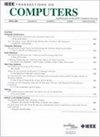Optimized Quantum Circuit of AES With Interlacing-Uncompute Structure
IF 3.6
2区 计算机科学
Q2 COMPUTER SCIENCE, HARDWARE & ARCHITECTURE
引用次数: 0
Abstract
In the post-quantum era, the security level of encryption algorithms is often evaluated based on the quantum resources required to attack AES. In this work, we make thoroughly estimations on various performance metrics of the quantum circuit of AES-128/192/256. Firstly, we introduce a generic round structure for in-place implementation of the AES algorithm, maximizing the parallelism between nonlinear components. Specifically, when employed as an encryption oracle, our structure reduces the具有交错-非计算结构的 AES 优化量子电路
在后量子时代,加密算法的安全等级通常是根据攻击 AES 所需的量子资源来评估的。在这项工作中,我们对 AES-128/192/256 的量子电路的各种性能指标进行了全面估算。首先,我们引入了一种用于就地实现 AES 算法的通用轮结构,最大限度地提高了非线性组件之间的并行性。具体来说,当作为加密甲骨文使用时,我们的结构将 $T$ 深度从 2rd$ 减少到 $(r+1)d$。此外,通过利用块周期矩阵的特性,我们提出了深度为 10 的 MixColumn 就地实现电路,使用了 105 个 CNOT 门。关于 S-box,我们评估了其在不同 T$ 深度下的最小电路宽度,并提供了多个版本的电路实现,以权衡深度和宽度。最后,基于优化后的 S-box 电路,我们对不同圆形结构的实现复杂性进行了全面分析,其中我们的结构在低 T$ 深度方面具有显著优势。
本文章由计算机程序翻译,如有差异,请以英文原文为准。
求助全文
约1分钟内获得全文
求助全文
来源期刊

IEEE Transactions on Computers
工程技术-工程:电子与电气
CiteScore
6.60
自引率
5.40%
发文量
199
审稿时长
6.0 months
期刊介绍:
The IEEE Transactions on Computers is a monthly publication with a wide distribution to researchers, developers, technical managers, and educators in the computer field. It publishes papers on research in areas of current interest to the readers. These areas include, but are not limited to, the following: a) computer organizations and architectures; b) operating systems, software systems, and communication protocols; c) real-time systems and embedded systems; d) digital devices, computer components, and interconnection networks; e) specification, design, prototyping, and testing methods and tools; f) performance, fault tolerance, reliability, security, and testability; g) case studies and experimental and theoretical evaluations; and h) new and important applications and trends.
 求助内容:
求助内容: 应助结果提醒方式:
应助结果提醒方式:


